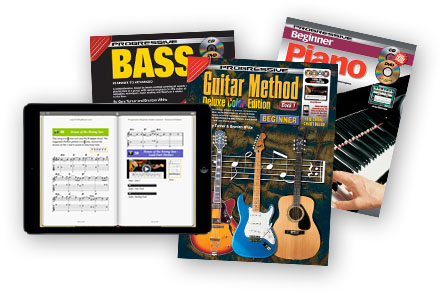<< First < Previous | Intro 1 2 3 4 5 | Next > Last >>
Back to Table of Contents
| 24 | (Lead Part Notes) |
Video
| 24 | (Rhythm Part Chords) |
Video
Minor Chords
There are three main types of chords: Major, Seventh and Minor. The chord symbol for the minor chord is a small ‘m’ placed after the letter name.
| 25 | (Lead Part Notes) |
Video
| 25 | (Rhythm Part Chords) |
Video
Turnaround Progressions
In Lesson 4, you were introduced to the 12 Bar Blues chord progression. Another common chord progression to learn is called the Turnaround. Like 12 Bar Blues, it is the basis of many songs, and it will probably sound familiar to you. Unlike 12 Bar Blues, where the progression occurs over a fixed number of bars, the Turnaround progression may vary in length as in the examples that follow, however the chord sequence remains the same. Some of the biggest hit records of all time are based upon the Turnaround progression. Every year since the beginning of Rock music there are hit songs based upon 12 Bar Blues and Turnaround progressions.
Songs using the Turnaround progression
- Stand by Me – John Lennon
- I Will Always Love You – Whitney Houston
- Return to Sender – Elvis Presley
- All I Have to do is Dream – Everly Brothers
- Be My Baby – The Ronettes
- Everlasting Love – U2
- Can’t Smile Without You – Barry Manilow
- Please Mr Postman – The Beatles
- Blue Moon – Various Artists
- Tell Me Why – The Beatles
- Lets Twist Again – Chubby Checker
All Turnaround progressions contain at least one minor chord. The following chord progression is a Turnaround in the key of G and it contains a new chord, E minor (Em).
| 26 | Turnaround in the Key of G Major |
Video
| 27 | Turnaround in the Key of G Major (Lead Part Notes) |
Video
| 27 | Turnaround in the Key of G Major (Rhythm Part Chords) |
Video
| 28 | Turnaround in the Key of C Major (Lead Part Notes) |
Video
| 28 | Turnaround in the Key of C Major (Rhythm Part Chords) |
Video
<< First < Previous | Intro 1 2 3 4 5 | Next > Last >>
Back to Table of Contents















































